The Greater Yellowstone Coalition and the WYldlife Fund Partner to Raise $2.7 Million for Wyoming’s Highway 26 Wildlife Crossing Project


The WYldlife Fund (The Fund) embarked on its inaugural large-scale project, the I-25 Kaycee to Buffalo Wildlife Crossing Project, with a remarkable contribution exceeding $350,000. We are elated to share that the project has reached the impressive milestone of 60% completion, with an anticipated finish by fall of this year. Getting to see a project from beginning to end is hugely rewarding for us, and we can’t wait to see the benefits this project brings to wildlife populations, especially to local mule deer herds.
Now, let’s delve into the backstory of this significant endeavor:
In 2014, during public meetings of the Wyoming Game and Fish Department (WGFD) Mule Deer Initiative, concerns regarding the Powder River Mule Deer Herd’s population were voiced. The population had fallen below the objective of 18,000 animals since the early 2000s.
Hunters also noticed a decline in mule deer numbers, resulting in diminished hunting opportunities. Factors such as disease, habitat loss, and highway and transportation infrastructure contributed to this decline.
A specific section of I-25 near Kaycee (mileposts 255-270) was identified as having the second-highest rate of deer collisions on a Wyoming interstate, impeding the safe movement of mule deer seeking additional habitat. This project emerged as a Top 10 Statewide highway crossing priority during the Wyoming Wildlife and Roadways Summit in 2017.
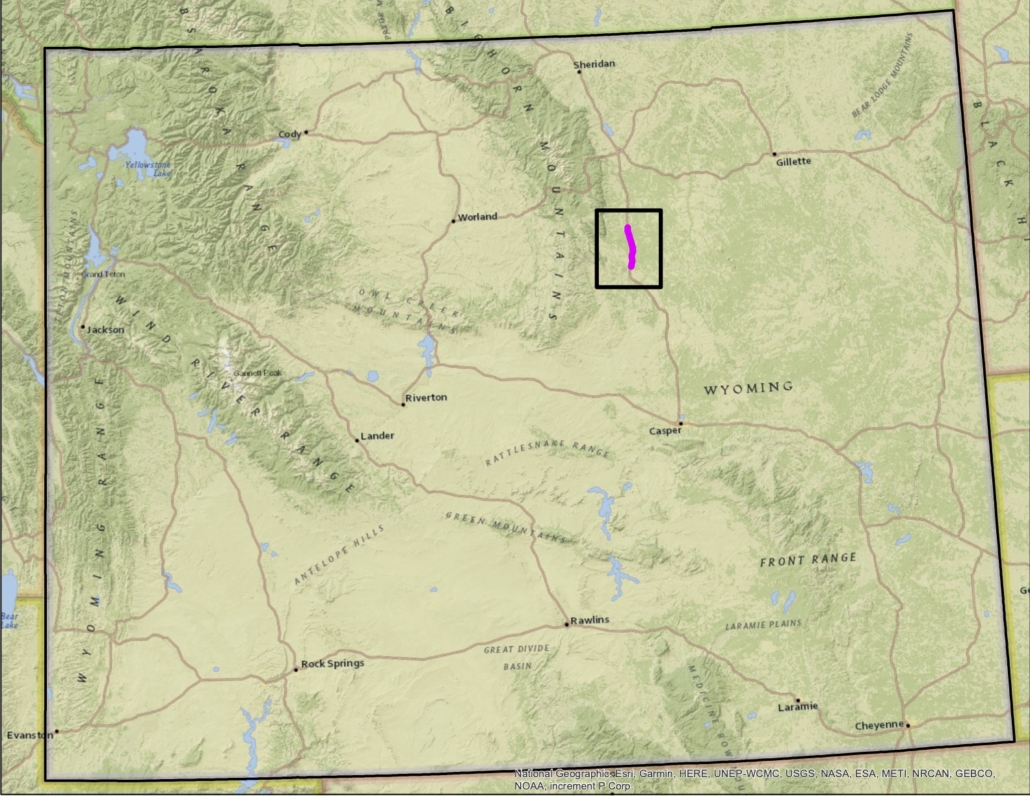
Map highlighting (in pink) the section of highway where the crossing is being constructed.
Statewide, over 6,000 animals, including deer, pronghorn, elk, moose, bighorn sheep, and mountain goats, succumb to wildlife-vehicle collisions (WVCs) each year. The I-25 Kaycee to Buffalo Wildlife Crossing Project aims to mitigate these collisions by facilitating safe passage for wildlife and reducing overall WVC numbers. The project employs exclusionary fencing to guide wildlife to six existing crossing structures, including underpasses, bridges, and culverts. Additionally, deer ramps, gates, and cattle guards are being installed as needed.
The project entails constructing 36 miles of fencing (18 miles on each side of the interstate), requiring 10,000 wooden posts. An intriguing fact—168,000 hog rings, installed by hand, are needed to attach fencing material to the wooden posts. Jumpouts, like the one seen below within the project, are gradual ramps which help wildlife escape the highway corridor should they somehow become trapped.
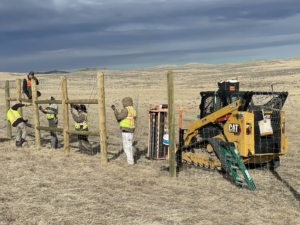
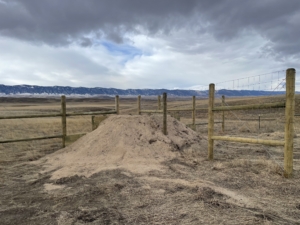
The new fencing directs animals to crossing structures, ensuring safe passage for wildlife and enhancing the safety of interstate travelers. Wyoming currently witnesses 21 big-game collisions daily, with eight involving significant vehicle damage and/or human injury. WVCs cost the state approximately $55 million annually. This project aims to reduce these numbers, safeguarding wildlife, humans, and the state’s budget.
The Fund has diligently monitored existing underpasses with trail cameras since the project’s initiation, capturing numerous mule deer and other charismatic species utilizing them for safe passage across the interstate.
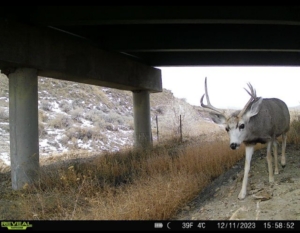
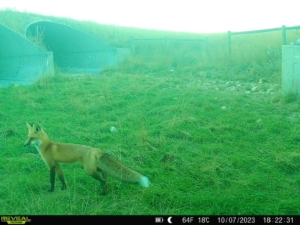
This impactful project owes its existence to the generous support of our sponsors. We extend heartfelt gratitude to the Bass Pro Shops and Cabela’s Outdoor Fund, Golf For Wildlife Outing Supporters, Knobloch Family Foundation, Muley Fanatic Foundation, Williams Energy, Wyoming Wildlife and Natural Resource Trust, Wyoming Department of Transportation and Commission, and Wyoming Game and Fish Department and Commission for making this endeavor possible.
We have some exciting news to share in the world of wildlife crossings! But first, a bit of background:
According to Dr. Corinna Riginos of The Nature Conservancy, the annual number of wildlife-vehicle collisions (WVCs) continues to rise over time, with a current five-year average of 7,656 animals per year. The vast majority of these collisions (approx. 5,500) involve mule deer, whose numbers are already in decline. There are currently 21 big-game collisions every day in Wyoming, eight of which involve significant damage to vehicles and/or human injury. The total cost of WVCs in Wyoming average about $55 million per year. These numbers have doubled over the last 15 years, and we can expect them to double again by 2035 if we don’t address the problem. Further, the actual number of collisions and dead animals is likely twice the number that gets counted, due to undetected mortalities away from the roadside.
Since The WYldlife Fund’s inception in 2020, we have made it a top priority to help fund wildlife crossing projects and ensure the safety and survival of wildlife populations most negatively affected by roads. The first large-scale project we helped fully fund was the I-25 Buffalo-to-Kaycee Wildlife Crossing Project. Currently, this project is 90% complete and includes close to 20 miles of big game exclusionary fencing to direct wildlife–mainly mule deer–to existing underpasses.
Earlier this year, The WYldlife Fund began work to raise and pool private funds to support another wildlife crossing project: the HWY-189 South Kemmerer Wildlife Crossing Project.
There is a particular 30-mile stretch along Highway 189 in southwest Wyoming that has seen significant WVCs with pronghorn and mule deer, according to the Wyoming Department of Transportation (WYDOT). These collisions are causing population-level impacts to pronghorn and are disrupting migratory and winter-range movements of mule deer from the Uinta and Wyoming Range Mule Deer Herds. These herds were severely impacted during the harsh 2022-‘23 winter, with biologists reporting upwards of 70% mortality.
This wildlife crossing project would reduce WVCs and promote habitat connectivity for ungulates by directing animals to existing and new wildlife crossing structures. It will also ensure humans can more safely travel this highway, as WVCs are very injurious not only to wildlife, and it will create a plethora of jobs for Wyoming’s workforce. The project is a huge undertaking: to complete it, existing fences will be replaced and five underpasses and one overpass will be constructed. A similar 13-mile-long wildlife crossing project in nearby Nugget Canyon reduced WVCs by 81% while allowing 49,146 mule deer to safely cross the highway during a three-year period, according to Hall Sawyer, Research Biologist at West Inc. We hope to see similar statistics for the Kemmerer project.
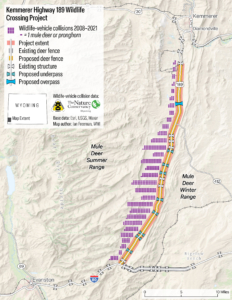
Understandably, a project of this magnitude requires an extensive budget. Together, WYDOT and the Wyoming Game and Fish Department applied for a federal grant through the Wildlife Crossing Pilot Program, which is funded by the Bipartisan Infrastructure Law. The WYldlife Fund helped raise close to $1 million to bolster the federal grant request, which was crucial given the highly competitive nature of the grant process. We also helped garner over 20 support letters for the grant application itself.
The partners who came together through The WYldlife Fund to donate this money are Genesis Alkali Wyoming, the Knobloch Family Foundation, the Mule Deer Foundation, the Muley Fanatic Foundation Blue Ridge Chapter, the Muley Fanatic Foundation Headquarters, the NextEra Energy Foundation, Project West, the Rocky Mountain Power Foundation, SOS Well Services, the supporters of the annual Golf for Wildlife Outing, Spire Storage, TerraPower, The WYldlife Fund, the Wildlife Barrier Breakers Coalition, Williams Energy, and the Wyoming Wildlife Federation. We are beyond grateful for their invaluable support.
Now, for the exciting news we mentioned:
The Federal Highway Administration Award is part of $350 million available through the federal wildlife crossing pilot program. Approximately $112 million was allocated during this first round of awards, with WYDOT receiving more than 20 percent of the available funding for the Kemmerer project–$24.3 million, to be exact!
What’s more, the Wyoming Transportation Commission, Game and Fish Commission, Wyoming Wildlife and Natural Resource Trust, and partners contributed the remaining $8.8 million (which includes private donations to The WYldlife Fund), making the project fully funded!
“I am thankful and excited to have had the opportunity to work with WYDOT, Game and Fish, industry, foundations, and nonprofit organizations to secure this incredibly important funding source to conserve Wyoming’s iconic wildlife,” said Chris McBarnes, President of The WYldlife Fund. “Wyoming is showing the power of public-private partnerships which will continue to produce positive results for wildlife and advance the overall prosperity of our state.”
It has been a very exciting week for all of us, and we are thrilled to be able to share this news with you. Another win for wildlife!
Head here to read the full press release from the Governor’s Office, Game and Fish, and WYDOT!
This project around Dubois from Stoney Point to Dinwoody Creek (mileposts 48-73) meets a major need in keeping our wildlife and drivers on the go.
The forthcoming economic development opportunities in this region, and resulting increase in motor vehicle traffic, has made it imperative that we work together to complete the Kemmerer Highway 189 Wildlife Crossing Project in order to protect human lives and save wildlife.
The Dry Piney area of US Highway 189 lies in critical winter range for the vibrant Wyoming Range Mule deer herd, which provides world-class hunting and wildlife viewing opportunities